Soyuz TM-15
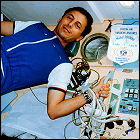 The Russian spacecraft Soyuz TM-15 lifts off from Kazakhstan, carrying cosmonauts Anatoly Solovyev and Sergei Avdeyev, along with French spationaut Michel Tognini, to space station Mir. Tognini remains aboard Mir for two weeks, returning with the Soyuz TM-14 crew, while Solovyev and Avdeyev are aboard for the long haul, manning Mir for 188 days before returning to Earth early in 1993.
The Russian spacecraft Soyuz TM-15 lifts off from Kazakhstan, carrying cosmonauts Anatoly Solovyev and Sergei Avdeyev, along with French spationaut Michel Tognini, to space station Mir. Tognini remains aboard Mir for two weeks, returning with the Soyuz TM-14 crew, while Solovyev and Avdeyev are aboard for the long haul, manning Mir for 188 days before returning to Earth early in 1993.
Soyuz TM-14: Russia in space
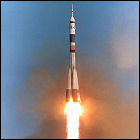 Soyuz TM-14 lifts off from the Baikonur Cosmodrome in Kazakhstan, the first space mission from post-Soviet Russia. It carries cosmonauts Alexander Viktorenko, Alexander Kaleri, and Klaus-Dietrich Flade to space station Mir. Viktorenko and Kaleri remain aboard Mir for 145 days, while Flade returns to Earth with the previous station crew aboard Soyuz TM-13. When TM-14 returns to Earth in August 1992, Viktorenko and Kaleri suffer an unusual landing, with their descent module rolling to an upside-down position, trapping the cosmonauts inside until rescue crews arrive.
Soyuz TM-14 lifts off from the Baikonur Cosmodrome in Kazakhstan, the first space mission from post-Soviet Russia. It carries cosmonauts Alexander Viktorenko, Alexander Kaleri, and Klaus-Dietrich Flade to space station Mir. Viktorenko and Kaleri remain aboard Mir for 145 days, while Flade returns to Earth with the previous station crew aboard Soyuz TM-13. When TM-14 returns to Earth in August 1992, Viktorenko and Kaleri suffer an unusual landing, with their descent module rolling to an upside-down position, trapping the cosmonauts inside until rescue crews arrive.
Soyuz TM-13: the last Soviet space mission
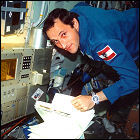 The Soviet Union launches its last space mission, Soyuz TM-13, carrying cosmonauts Alexander Volkov, Toktar Aubakirov and the first Austrian in space, Franz Viehböck, to space station Mir. After a week in space, Aubakirov and Viehböck return to Earth aboard Soyuz TM-12 with incumbent station crewmember Anatoly Artsebarksky, while Volkov stays for 175 days (alongside Krikalev, who will have been in space for 10 months by the time he returns to Earth in 1992). During Volkov and Krikalev’s stay aboard Mir, the Soviet Union collapses; they instead return to Earth as Russian citizens.
The Soviet Union launches its last space mission, Soyuz TM-13, carrying cosmonauts Alexander Volkov, Toktar Aubakirov and the first Austrian in space, Franz Viehböck, to space station Mir. After a week in space, Aubakirov and Viehböck return to Earth aboard Soyuz TM-12 with incumbent station crewmember Anatoly Artsebarksky, while Volkov stays for 175 days (alongside Krikalev, who will have been in space for 10 months by the time he returns to Earth in 1992). During Volkov and Krikalev’s stay aboard Mir, the Soviet Union collapses; they instead return to Earth as Russian citizens.
Soyuz TM-12: the first British astronaut
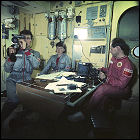 Helen Sharman becomes the first British national in space, flying aboard Soyuz TM-12 to the Soviet space station Mir. Making her flight in a seat bought and paid for by a consortium of British commercial interests, Sharman tags along with cosmonauts Anatoly Artsebarsky and Sergei Krikalev, and she spends just a week in orbit before returning with Soyuz TM-13 cosmonaut Toktar Aubakirov. Artsebarsky and Krikalev remain aboard Mir for what is initially planned to be a five-month stay, though a shake-up in the flight schedule forces mission planners to ask Krikalev to stay aboard Mir even after Artsebarsky returns to Earth, resulting in Krikalev remaining on Mir for 10 months, not returning home until 1992 – at which point the Soviet Union will have ceased to exist.
Helen Sharman becomes the first British national in space, flying aboard Soyuz TM-12 to the Soviet space station Mir. Making her flight in a seat bought and paid for by a consortium of British commercial interests, Sharman tags along with cosmonauts Anatoly Artsebarsky and Sergei Krikalev, and she spends just a week in orbit before returning with Soyuz TM-13 cosmonaut Toktar Aubakirov. Artsebarsky and Krikalev remain aboard Mir for what is initially planned to be a five-month stay, though a shake-up in the flight schedule forces mission planners to ask Krikalev to stay aboard Mir even after Artsebarsky returns to Earth, resulting in Krikalev remaining on Mir for 10 months, not returning home until 1992 – at which point the Soviet Union will have ceased to exist.
Soyuz TM-11: live from orbit
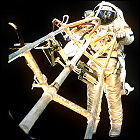 Soyuz TM-11 lifts off from the Baikonur Cosmodrome in the Soviet Union, bound for the space station Mir. Aboard the Soyuz is a crew of three: cosmonauts Viktor Afanasyev and Musa Manarov, with Tokyo Broadcasting System reporter Toyohiro Akiyama, who transmits live reports from Mir for the duration of his week in orbit. (Akiyama will return to Earth with the Soyuz TM-10 crew.) Akiyama is the first space traveler whose seat has been commercially bought and paid for, a flight which ignites the “space tourism” industry built around buying Soyuz seats. Afanasyev and Manarov remain in orbit for 175 days, returning to Earth with British space traveler Helen Sharman in May 1991.
Soyuz TM-11 lifts off from the Baikonur Cosmodrome in the Soviet Union, bound for the space station Mir. Aboard the Soyuz is a crew of three: cosmonauts Viktor Afanasyev and Musa Manarov, with Tokyo Broadcasting System reporter Toyohiro Akiyama, who transmits live reports from Mir for the duration of his week in orbit. (Akiyama will return to Earth with the Soyuz TM-10 crew.) Akiyama is the first space traveler whose seat has been commercially bought and paid for, a flight which ignites the “space tourism” industry built around buying Soyuz seats. Afanasyev and Manarov remain in orbit for 175 days, returning to Earth with British space traveler Helen Sharman in May 1991.
Soyuz TM-10
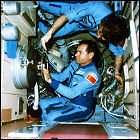 The Soviet Union launches Soyuz TM-10, carrying cosmonauts Gennadi Manakov and Gennady Strekalov to space station Mir for a long-duration stay in orbit. After a 130-day stay aboard Mir, the TM-10 crew returns, bringing with them Japanese TV reporter Toyohiro Akiyama, who would arrive aboard Mir via Soyuz TM-11 in December. Strekalov will return to serve another tour aboard Mir in the 1990s, becoming the first Russian cosmonaut to arrive in a Soyuz and return home in an American space shuttle.
The Soviet Union launches Soyuz TM-10, carrying cosmonauts Gennadi Manakov and Gennady Strekalov to space station Mir for a long-duration stay in orbit. After a 130-day stay aboard Mir, the TM-10 crew returns, bringing with them Japanese TV reporter Toyohiro Akiyama, who would arrive aboard Mir via Soyuz TM-11 in December. Strekalov will return to serve another tour aboard Mir in the 1990s, becoming the first Russian cosmonaut to arrive in a Soyuz and return home in an American space shuttle.
Soyuz TM-9 / Mir Expedition EO-6
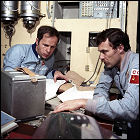 Cosmonauts Anatoly Solovyev
Cosmonauts Anatoly Solovyev
and Aleksandr Balandin lift off from the Soviet Union aboard Soyuz TM-9, on their way to a stay aboard the Mir space station. Upon arriving at the station, an inspection of their spacecraft reveals that some of the Soyuz’ thermal blankets detached themselves during launch, though ground controllers decide against such drastic measures as cutting the mission short or launching Soyuz TM-10 early as a rescue mission. Solovyev and Balandin remain aboard Mir for 179 days, greeting the station’s next crew in August and returning to Earth without incident.
Soyuz TM-8 / Mir Expedition EO-5
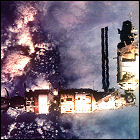 Cosmonauts Alexander Viktorenko and Aleksandr Serebrov lift off aboard the Soviet spacecraft Soyuz TM-8, bound for the presently unoccupied space station Mir (which had been left without a crew since April 1989). At a distance of only 4 meters to Mir’s docking hatch, Soyuz TM-8 suffers a breakdown of its automated docking system, and Viktorenko has no choice but to back the Soyuz away and carefully dock under manual control. The two-man crew remains aboard Mir for 166 days, returning to Earth in February 1990.
Cosmonauts Alexander Viktorenko and Aleksandr Serebrov lift off aboard the Soviet spacecraft Soyuz TM-8, bound for the presently unoccupied space station Mir (which had been left without a crew since April 1989). At a distance of only 4 meters to Mir’s docking hatch, Soyuz TM-8 suffers a breakdown of its automated docking system, and Viktorenko has no choice but to back the Soyuz away and carefully dock under manual control. The two-man crew remains aboard Mir for 166 days, returning to Earth in February 1990.
Soyuz TM-7
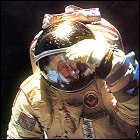 The Soviet Union launches Soyuz TM-7 to space station Mir, ferrying cosmonauts Alexander Volkov and Sergei Krikalev, and French spationaut Jean-Loup Chrétien to the station. Volkov and Krikalev will remain aboard Mir for 151 days, while Chrétien will remain for a shorter 24-day mission. Chrétien had visited the Salyut 7 space station on his previous spaceflight; his next flight, in 1997, will visit Mir again, this time by way of Space Shuttle Atlantis. Unusually, the return of this Mir crew will leave the station unoccupied for almost half a year.
The Soviet Union launches Soyuz TM-7 to space station Mir, ferrying cosmonauts Alexander Volkov and Sergei Krikalev, and French spationaut Jean-Loup Chrétien to the station. Volkov and Krikalev will remain aboard Mir for 151 days, while Chrétien will remain for a shorter 24-day mission. Chrétien had visited the Salyut 7 space station on his previous spaceflight; his next flight, in 1997, will visit Mir again, this time by way of Space Shuttle Atlantis. Unusually, the return of this Mir crew will leave the station unoccupied for almost half a year.
Did you go before leaving the space station?
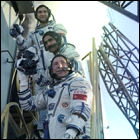 Cosmonauts Vladimir Lyakhov and Abdul Ahad Mohmand, the first Afghan in space, undock from the Mir space station and prepare to return home, jettisoning the orbital module of their Soyuz TM-5 space capsule per standard procedure. But their descent module – the only part of a Soyuz that ever returns to Earth intact – experiences numerous technical glitches, and ground controllers in the Soviet Union order them to stay in orbit for an extra day. That’s easy enough for engineers on Earth to say: the abandoned orbital module contains the only toilet facilities on a Soyuz spacecraft, leaving the crew to hold everything until their return on September 7th; there is also no fresh water available. Needless to say, Soviet mission planners redraw the rules of future missions to keep the orbital module attached until the last possible moment with safety guidelines.
Cosmonauts Vladimir Lyakhov and Abdul Ahad Mohmand, the first Afghan in space, undock from the Mir space station and prepare to return home, jettisoning the orbital module of their Soyuz TM-5 space capsule per standard procedure. But their descent module – the only part of a Soyuz that ever returns to Earth intact – experiences numerous technical glitches, and ground controllers in the Soviet Union order them to stay in orbit for an extra day. That’s easy enough for engineers on Earth to say: the abandoned orbital module contains the only toilet facilities on a Soyuz spacecraft, leaving the crew to hold everything until their return on September 7th; there is also no fresh water available. Needless to say, Soviet mission planners redraw the rules of future missions to keep the orbital module attached until the last possible moment with safety guidelines.
Soyuz TM-6
 The Soviet Union launches the Soyuz TM-6 mission to the Mir space station, with cosmonauts Vladimir Lyakhov, Valeri Polyakov and Abdul Ahad Mohmand aboard. Lyakhov and Mohmand remain aboard Mir for only a week, participating in experiments involving both crews, but Polyakov, a medical doctor, remains on Mir to monitor the Expedition 3 crew in the final months of their unprecedented one-year stay in orbit. This crew exchanges spacecraft with the station crew, returning home in the Soyuz TM-5 vehicle after a week on Mir, but their return is plagued by problems both technical and otherwise.
The Soviet Union launches the Soyuz TM-6 mission to the Mir space station, with cosmonauts Vladimir Lyakhov, Valeri Polyakov and Abdul Ahad Mohmand aboard. Lyakhov and Mohmand remain aboard Mir for only a week, participating in experiments involving both crews, but Polyakov, a medical doctor, remains on Mir to monitor the Expedition 3 crew in the final months of their unprecedented one-year stay in orbit. This crew exchanges spacecraft with the station crew, returning home in the Soyuz TM-5 vehicle after a week on Mir, but their return is plagued by problems both technical and otherwise.
Soyuz TM-5
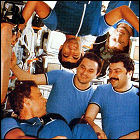 Cosmonauts Anatoly Solovyev, Viktor Savinykh and Aleksandr Aleksandrov lift off for a week-long visit to Soviet space station Mir aboard Soyuz TM-5. Numerous biological and astronomical experiments are conducted by the blended crew, and at the end of the week of joint activities, the Soyuz TM-5 crew use the older TM-4 capsule to return home, leaving the station crew with a newer vehicle.
Cosmonauts Anatoly Solovyev, Viktor Savinykh and Aleksandr Aleksandrov lift off for a week-long visit to Soviet space station Mir aboard Soyuz TM-5. Numerous biological and astronomical experiments are conducted by the blended crew, and at the end of the week of joint activities, the Soyuz TM-5 crew use the older TM-4 capsule to return home, leaving the station crew with a newer vehicle.
Soyuz TM-4 / Mir Expedition 3
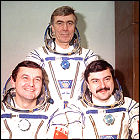 The Soyuz TM-4 mission is launched by the Soviet Union, en route to space station Mir. Cosmonauts Vladimir Titov and Musa Manarov take up residence as the new long-duration crew aboard Mir, formally known as Expedition 3, and they eventually break all previous space endurance records by staying aboard Mir for exactly one year and one day, returning to Earth on December 21st, 1988. Cosmonaut Anatoli Levchenko, after the week-long overlap with the Expedition 2 crew, returns to Earth with Expedition 2 crew members Yuri Romanenko and Aleksandr Aleksandrov aboard the Soyuz TM-3 vehicle.
The Soyuz TM-4 mission is launched by the Soviet Union, en route to space station Mir. Cosmonauts Vladimir Titov and Musa Manarov take up residence as the new long-duration crew aboard Mir, formally known as Expedition 3, and they eventually break all previous space endurance records by staying aboard Mir for exactly one year and one day, returning to Earth on December 21st, 1988. Cosmonaut Anatoli Levchenko, after the week-long overlap with the Expedition 2 crew, returns to Earth with Expedition 2 crew members Yuri Romanenko and Aleksandr Aleksandrov aboard the Soyuz TM-3 vehicle.
Soyuz TM-3
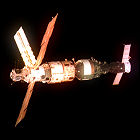 The Soviet Union launches Soyuz TM-3 on an eight-day mission into space which includes a visit to space station Mir. Cosmonauts Aleksandr Aleksandrov and Muhammed Faris (the latter of whom is the first Syrian space traveler) return to Earth at the end of the mission, along with Mir crew member Yuri Romanenko, while Alexander Viktorenko takes Romanenko’s slot on Mir. In order to leave the newer vehicle docked to Mir as an escape craft, the Soyuz TM-3 crew returns aboard Soyuz TM-2.
The Soviet Union launches Soyuz TM-3 on an eight-day mission into space which includes a visit to space station Mir. Cosmonauts Aleksandr Aleksandrov and Muhammed Faris (the latter of whom is the first Syrian space traveler) return to Earth at the end of the mission, along with Mir crew member Yuri Romanenko, while Alexander Viktorenko takes Romanenko’s slot on Mir. In order to leave the newer vehicle docked to Mir as an escape craft, the Soyuz TM-3 crew returns aboard Soyuz TM-2.
Soyuz TM-2 / Mir Expedition 2
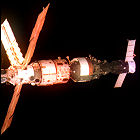 The Soviet Union launches Soyuz TM-2, the first manned launch of a newly uprated version of the Soyuz capsule. Cosmonauts Yuri Romanenko and Aleksandr Laveykin travel to the Mir space station, where Laveykin remains for 174 days before departing in July, but Romanenko sets a new space endurance record, remaining in orbit for 326 days. Romanenko’s return to Earth just before the end of 1987 marks the end of Expedition 2’s occupancy of Mir.
The Soviet Union launches Soyuz TM-2, the first manned launch of a newly uprated version of the Soyuz capsule. Cosmonauts Yuri Romanenko and Aleksandr Laveykin travel to the Mir space station, where Laveykin remains for 174 days before departing in July, but Romanenko sets a new space endurance record, remaining in orbit for 326 days. Romanenko’s return to Earth just before the end of 1987 marks the end of Expedition 2’s occupancy of Mir.
Soyuz T-15 / Mir Expedition 1
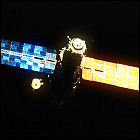 The Soviet Union launches Soyuz T-15 on an unprecedented mission into orbit. Cosmonauts Leonid Kizim and Vladimir Solovyov become the first occupants of the newly-launched Mir space station on March 15th, where they remain until early May, at which time they undock the Soyuz T-15 vehicle from Mir and visit the powered-down Salyut 7 space station, becoming its final occupants until they return to Mir in late June, bringing several pieces of equipment and experiments cannibalized from Salyut back with them. The crew spends a total of 125 days in space, at the end of which Kizim is the most-traveled man in space, having accumulated over a year of total space travel time. Soyut T-15 is the last second-generation Soyuz vehicle to fly, returning to Earth on July 16th.
The Soviet Union launches Soyuz T-15 on an unprecedented mission into orbit. Cosmonauts Leonid Kizim and Vladimir Solovyov become the first occupants of the newly-launched Mir space station on March 15th, where they remain until early May, at which time they undock the Soyuz T-15 vehicle from Mir and visit the powered-down Salyut 7 space station, becoming its final occupants until they return to Mir in late June, bringing several pieces of equipment and experiments cannibalized from Salyut back with them. The crew spends a total of 125 days in space, at the end of which Kizim is the most-traveled man in space, having accumulated over a year of total space travel time. Soyut T-15 is the last second-generation Soyuz vehicle to fly, returning to Earth on July 16th.
Soyuz T-14
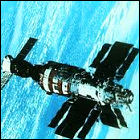 The Soviet Union launches the Soyuz T-14 mission, carrying a crew of three cosmonauts intended to become the next long-term occupants of space station Salyut 7. The crew consists of Vladimir Vasyutin, Georgi Grechko and Alexander Volkov, though Grechko only remains until September 26th, returning to Earth with the Soyuz T-13 crew. Two months into the crew’s stay on Salyut, however, Vasyutin becomes seriously ill. Communications between the station and ground controllers are carried out on a scrambled frequency for a week, at which point the crew is recalled to Earth, ending an occupancy that was meant to last for half a year. Soyuz T-14 returns to Earth, carring Vasyutin, Volkov and Soyuz T-13 crew member Viktor Savinykh home on November 21st, once again leaving Salyut 7 unoccupied for several months.
The Soviet Union launches the Soyuz T-14 mission, carrying a crew of three cosmonauts intended to become the next long-term occupants of space station Salyut 7. The crew consists of Vladimir Vasyutin, Georgi Grechko and Alexander Volkov, though Grechko only remains until September 26th, returning to Earth with the Soyuz T-13 crew. Two months into the crew’s stay on Salyut, however, Vasyutin becomes seriously ill. Communications between the station and ground controllers are carried out on a scrambled frequency for a week, at which point the crew is recalled to Earth, ending an occupancy that was meant to last for half a year. Soyuz T-14 returns to Earth, carring Vasyutin, Volkov and Soyuz T-13 crew member Viktor Savinykh home on November 21st, once again leaving Salyut 7 unoccupied for several months.
Soyuz T-13: saving Salyut 7
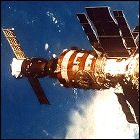 The Soviet Union launches Soyuz T-13 on a mission to salvage space station Salyut 7, which has gone unoccupied for more than half a year and has lost power and attitude control. Cosmonauts Vladimir Dzhanibekov and Viktor Savinykh find the station dead in space, tumbling slowly, forcing them to use their Soyuz vehicle’s thrusters to match the station’s erratic motion to allow a manual docking. Inside the station, the crew finds frigid but breathable air, and again the Soyuz engines are fired to orient the station so its solar panels catch enough sunlight to charge its batteries. After a week of work carried out in bulky clothing befitting a Russian winter, the cosmonauts reactivate the station fully, scoring a major space first – the first-ever docking with, and repair of, a fully deactivated space station. For the first time, a Salyut crew spends some overlap time with the next long-term crew, a step toward the uninterrupted occupancy that will become commonplace aboard Mir, Salyut’s successor. Savinykh remains aboard Salyut 7 for 168 days, overlapping into the next long-term station crew, while Dzhanibekov departs 110 days into his stay.
The Soviet Union launches Soyuz T-13 on a mission to salvage space station Salyut 7, which has gone unoccupied for more than half a year and has lost power and attitude control. Cosmonauts Vladimir Dzhanibekov and Viktor Savinykh find the station dead in space, tumbling slowly, forcing them to use their Soyuz vehicle’s thrusters to match the station’s erratic motion to allow a manual docking. Inside the station, the crew finds frigid but breathable air, and again the Soyuz engines are fired to orient the station so its solar panels catch enough sunlight to charge its batteries. After a week of work carried out in bulky clothing befitting a Russian winter, the cosmonauts reactivate the station fully, scoring a major space first – the first-ever docking with, and repair of, a fully deactivated space station. For the first time, a Salyut crew spends some overlap time with the next long-term crew, a step toward the uninterrupted occupancy that will become commonplace aboard Mir, Salyut’s successor. Savinykh remains aboard Salyut 7 for 168 days, overlapping into the next long-term station crew, while Dzhanibekov departs 110 days into his stay.
Soyuz T-12
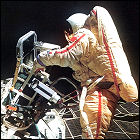 The Soviet Union launches Soyuz T-12 on a mission to space station Salyut 7. Cosmonauts Vladimir Dzhanibekov, Svetlana Savitskaya and Igor Volk visit the station crew and test new equipment during a three-hour spacewalk. Savitskaya becomes the first woman to fly in space twice as well as the first female spacewalker, an assignment that seems to have been devised purely for the political purpose of beating NASA to that first (the American space agency having announced in 1983 that an upcoming shuttle mission would feature a female spacewalker). Volk’s presence aboard the mission ensures that he has spaceflight experience ahead of his next mission, believed to be the first manned flight of the Soviet Buran shuttle. The Soyuz T-12 crew is in space for almost 12 days, returning to Earth on July 29th.
The Soviet Union launches Soyuz T-12 on a mission to space station Salyut 7. Cosmonauts Vladimir Dzhanibekov, Svetlana Savitskaya and Igor Volk visit the station crew and test new equipment during a three-hour spacewalk. Savitskaya becomes the first woman to fly in space twice as well as the first female spacewalker, an assignment that seems to have been devised purely for the political purpose of beating NASA to that first (the American space agency having announced in 1983 that an upcoming shuttle mission would feature a female spacewalker). Volk’s presence aboard the mission ensures that he has spaceflight experience ahead of his next mission, believed to be the first manned flight of the Soviet Buran shuttle. The Soyuz T-12 crew is in space for almost 12 days, returning to Earth on July 29th.
Soyuz T-11
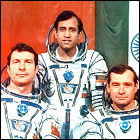 The Soviet Union launches Soyuz T-11 en route to space station Salyut 7. Spending nearly eight days in orbit, cosmonauts Yuri Malyshev, Gennady Strekalov and the first space traveler from India, Rakesh Sharma, perform experiments aboard the station as well as bringing supplies. They return to Earth on April 11th aboard the station crew’s Soyuz T-10 capsule, leaving the newer Soyuz T-11 docked at Salyut 7 for the station crew’s use.
The Soviet Union launches Soyuz T-11 en route to space station Salyut 7. Spending nearly eight days in orbit, cosmonauts Yuri Malyshev, Gennady Strekalov and the first space traveler from India, Rakesh Sharma, perform experiments aboard the station as well as bringing supplies. They return to Earth on April 11th aboard the station crew’s Soyuz T-10 capsule, leaving the newer Soyuz T-11 docked at Salyut 7 for the station crew’s use.
Soyuz T-10
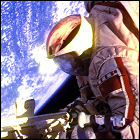 Delayed many months during the investigation into the causes of the Soyuz T-10a near-disaster in 1983, Soyuz T-10 lifts off from the Soviet Union. Cosmonauts Leonid Kizim, Vladimir Solovyov and Oleg Atkov take up residence on space station Salyut 7 for a 236-day stay – the longest duration crew of the entire Salyut space station program – during which they have to conduct repairs to the station both inside and outside in a series of spacewalks. Left unoccupied months longer than expected, the station has powered down and must be reactivated, a process taking nearly ten days. A fuel line break on the exterior of the station must be repaired as well. The crew remains aboard Salyut 7 through October.
Delayed many months during the investigation into the causes of the Soyuz T-10a near-disaster in 1983, Soyuz T-10 lifts off from the Soviet Union. Cosmonauts Leonid Kizim, Vladimir Solovyov and Oleg Atkov take up residence on space station Salyut 7 for a 236-day stay – the longest duration crew of the entire Salyut space station program – during which they have to conduct repairs to the station both inside and outside in a series of spacewalks. Left unoccupied months longer than expected, the station has powered down and must be reactivated, a process taking nearly ten days. A fuel line break on the exterior of the station must be repaired as well. The crew remains aboard Salyut 7 through October.
Soyuz T-10-A: launch pad disaster
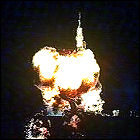 For the first time in history, a launch abort escape system saves its crew from a doomed launch. When a fuel spill is ignited at the base of the launch vehicle for Soyuz T-10-A – an otherwise routine mission to Soviet space station Salyut 7 – the entire rocket catches fire, and ground controllers quickly discover that cables running from their bunker to the vehicle have been severed, preventing them from remotely activating the launch escape tower. A radio frequency backup system finally sends the signal, and the tower blasts the Soyuz capsule free of its doomed rocket just two seconds prior to a massive explosion on the pad. The capsule brings the crew to a safe, but rough, landing a few miles away, while the launch pad fire burns out of control for nearly a day.
For the first time in history, a launch abort escape system saves its crew from a doomed launch. When a fuel spill is ignited at the base of the launch vehicle for Soyuz T-10-A – an otherwise routine mission to Soviet space station Salyut 7 – the entire rocket catches fire, and ground controllers quickly discover that cables running from their bunker to the vehicle have been severed, preventing them from remotely activating the launch escape tower. A radio frequency backup system finally sends the signal, and the tower blasts the Soyuz capsule free of its doomed rocket just two seconds prior to a massive explosion on the pad. The capsule brings the crew to a safe, but rough, landing a few miles away, while the launch pad fire burns out of control for nearly a day.
Soyuz T-9
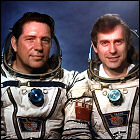 Soyuz T-9 lifts off from the Soviet Union, bringing a new long-term crew to space station Salyut 7. Cosmonauts Vladimir Lyakhov and Aleksandr Aleksandrov take up residence on Salyut 7 for a 150-day stay, including work aboard the recently-docked Kosmos 1443 temporary space station module. The disastrous failure of the next Soyuz mission to reach orbit means that Lyakhov and Aleksandrov spend their entire stay in orbit with no visits from other crews. They return to Earth on November 23rd.
Soyuz T-9 lifts off from the Soviet Union, bringing a new long-term crew to space station Salyut 7. Cosmonauts Vladimir Lyakhov and Aleksandr Aleksandrov take up residence on Salyut 7 for a 150-day stay, including work aboard the recently-docked Kosmos 1443 temporary space station module. The disastrous failure of the next Soyuz mission to reach orbit means that Lyakhov and Aleksandrov spend their entire stay in orbit with no visits from other crews. They return to Earth on November 23rd.
Soyuz T-8
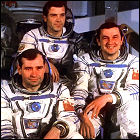 Soyuz T-8 lifts off from the Soviet Union, intended to dock with space station Salyut 7. Cosmonauts Vladimir Titov, Gennady Strekalov and Aleksandr Serebrov are due to take up residence on the station, but discover that the ejection of the nose cone of the Soyuz rocket – which protects the non-aerodynamic Soyuz vehicle during launch – has caused critical damage to the vehicle’s communication equipment. The mission is called off for safety reasons, and the crew returns to Earth after only two days.
Soyuz T-8 lifts off from the Soviet Union, intended to dock with space station Salyut 7. Cosmonauts Vladimir Titov, Gennady Strekalov and Aleksandr Serebrov are due to take up residence on the station, but discover that the ejection of the nose cone of the Soyuz rocket – which protects the non-aerodynamic Soyuz vehicle during launch – has caused critical damage to the vehicle’s communication equipment. The mission is called off for safety reasons, and the crew returns to Earth after only two days.
Soyuz T-7
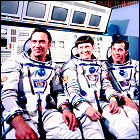 The Soviet Union’s Soyuz T-7 mission lifts off from Baikonur Cosmodrome for a week-long stay in space, including a visit to space station Salyut 7. The three-person Soyuz crew includes the first woman in space since 1963. Cosmonauts Leonid Popov, Aleksandr Serebrov and Svetlana Savitskaya deliver supplies to Salyut 7 and perform experiments while docked to the station; on August 27th, they depart from the station aboard the Soyuz T-5 vehicle, leaving the newer T-7 capsule for the station crew’s use.
The Soviet Union’s Soyuz T-7 mission lifts off from Baikonur Cosmodrome for a week-long stay in space, including a visit to space station Salyut 7. The three-person Soyuz crew includes the first woman in space since 1963. Cosmonauts Leonid Popov, Aleksandr Serebrov and Svetlana Savitskaya deliver supplies to Salyut 7 and perform experiments while docked to the station; on August 27th, they depart from the station aboard the Soyuz T-5 vehicle, leaving the newer T-7 capsule for the station crew’s use.
Soyuz T-6
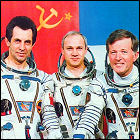 The Soviet Union launches the Soyuz T-6 mission on a week-long flight into orbit, including a visit to space station Salyut 7. Cosmonauts Vladimir Dzhanibekov, Aleksandr Ivanchenkov and Jean-Loup Chretien – the latter being the first Frenchman in space – spend several days aboard Salyut 7 performing experiments. Chretien would fly on later missions aboard Mir and the American Space Shuttle.
The Soviet Union launches the Soyuz T-6 mission on a week-long flight into orbit, including a visit to space station Salyut 7. Cosmonauts Vladimir Dzhanibekov, Aleksandr Ivanchenkov and Jean-Loup Chretien – the latter being the first Frenchman in space – spend several days aboard Salyut 7 performing experiments. Chretien would fly on later missions aboard Mir and the American Space Shuttle.
Soyuz T-5
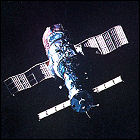 Soyuz T-5 lifts off from the Soviet Union, carrying its crew of two to the new Salyut 7 space station for a long-term stay. Cosmonauts Anatoli Berezovoy and Valentin Lebedev become Salyut 7’s first occupants, remaining aboard the station for a record-setting 211 days (almost seven months), not returning until December 1982. During that time, the two cosmonauts host two other visiting crews and launch a small amateur radio communications satellite by ejecting it from a small airlock.
Soyuz T-5 lifts off from the Soviet Union, carrying its crew of two to the new Salyut 7 space station for a long-term stay. Cosmonauts Anatoli Berezovoy and Valentin Lebedev become Salyut 7’s first occupants, remaining aboard the station for a record-setting 211 days (almost seven months), not returning until December 1982. During that time, the two cosmonauts host two other visiting crews and launch a small amateur radio communications satellite by ejecting it from a small airlock.
Soyuz 40
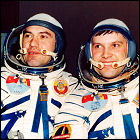 The final first-generation Soyuz spacecraft, Soyuz 40, is launched on a week-long spaceflight by the Soviet Union. With Leonid Popov and Romanian cosmonaut Dumitru Prunariu aboard, Soyuz 40 visits space station Salyut 6 for several days, and is the last spacecraft to dock at the five-year-old space station. The Soyuz 40 crew returns to Earth on May 22nd. Future Soyuz launches will use the upgraded Soyuz-T vehicles.
The final first-generation Soyuz spacecraft, Soyuz 40, is launched on a week-long spaceflight by the Soviet Union. With Leonid Popov and Romanian cosmonaut Dumitru Prunariu aboard, Soyuz 40 visits space station Salyut 6 for several days, and is the last spacecraft to dock at the five-year-old space station. The Soyuz 40 crew returns to Earth on May 22nd. Future Soyuz launches will use the upgraded Soyuz-T vehicles.
Soyuz 39
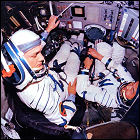 Soyuz 39 lifts off from the Soviet Union, carrying its two-man crew on a week-long spaceflight including a visit to space station Salyut 6. The crew consists of cosmonauts Vladimir Dzhanibekov and Jugderdemidiin Gurragchaa, the first Mongolian in space. In conjunction with the resident Salyut 6/Soyuz T-4 crew, they conduct scientific and engineering experiments, some of them studying the state of Salyut 6 after several years in orbit. The Soyuz 39 crew returns to Earth on March 30th.
Soyuz 39 lifts off from the Soviet Union, carrying its two-man crew on a week-long spaceflight including a visit to space station Salyut 6. The crew consists of cosmonauts Vladimir Dzhanibekov and Jugderdemidiin Gurragchaa, the first Mongolian in space. In conjunction with the resident Salyut 6/Soyuz T-4 crew, they conduct scientific and engineering experiments, some of them studying the state of Salyut 6 after several years in orbit. The Soyuz 39 crew returns to Earth on March 30th.
Soyuz T-4
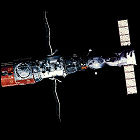 The Soyuz T-4 mission lifts off from the Soviet Union, carrying a two-man crew to space station Salyut 6. Cosmonauts Vladimir Kovalyonok and Viktor Savinykh remain about the station for 75 days, and are the last long-duration crew to occupy Salyut 6. Since they are still in orbit in April, they become the first Soviet crew to orbit the Earth at the same time as an American manned space vehicle since 1975, though the two never interact with each other at any point. The Soyuz T-4 capsule remains at the station as the escape vehicle until this crew departs in May.
The Soyuz T-4 mission lifts off from the Soviet Union, carrying a two-man crew to space station Salyut 6. Cosmonauts Vladimir Kovalyonok and Viktor Savinykh remain about the station for 75 days, and are the last long-duration crew to occupy Salyut 6. Since they are still in orbit in April, they become the first Soviet crew to orbit the Earth at the same time as an American manned space vehicle since 1975, though the two never interact with each other at any point. The Soyuz T-4 capsule remains at the station as the escape vehicle until this crew departs in May.